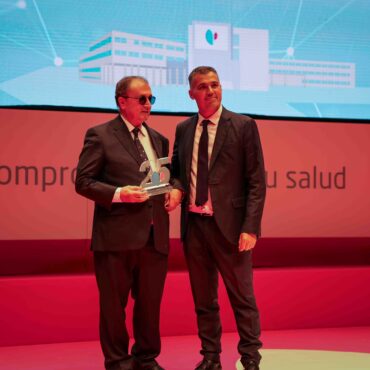-
 play_arrow
play_arrow
BayRadio Listen Live Broadcasting in Spain
What Is Fibromyalgia? Symptoms and Treatments of an Invisible Illness That Requires Specialized Attention


Close-up photo of curly-haired woman at home near the window with severe neck pain, mulatto business woman massaging her neck with closed eyes
The Pain Management Unit at Quirónsalud Torrevieja Hospital highlights the need to improve healthcare for patients living with fibromyalgia—a complex condition that demands specialized, compassionate, and individualized care. Despite its high global prevalence, fibromyalgia remains widely misunderstood and often misdiagnosed.
According to the World Health Organization, between 2% and 4% of the global population lives with fibromyalgia. In Spain alone, over one million people are affected. This syndrome is characterized by widespread chronic musculoskeletal pain, extreme fatigue, sleep disturbances, cognitive difficulties—often referred to as “brain fog”—and heightened sensitivity to physical contact.
More Than Pain: A Strong Emotional Component
Fibromyalgia causes not only physical suffering but also deeply affects emotional and social well-being. Diagnostic uncertainty, the invisibility of the pain, and a lack of understanding from others can lead to anxiety, depression, and even social isolation.
“At our Pain Units, we don’t just treat symptoms—we support people through their journey. We understand that someone with fibromyalgia doesn’t only need medical treatment but also to feel heard, understood, and respected,” says Dr. Fernando Leone, pain management specialist at Quirónsalud Torrevieja.
How Is Fibromyalgia Treated?
Treatment at specialized pain units begins with a thorough evaluation of the type of pain each patient experiences—whether nociceptive, neuropathic, or mixed. This allows the medical team to develop a personalized treatment plan that combines medication, advanced interventional techniques, emotional support, and recommendations to improve sleep, mobility, and independence.
Continuous follow-up is a key part of the approach, allowing treatment to be adapted according to the patient’s clinical progress. This helps strengthen the therapeutic bond and rebuild the patient’s confidence in their body and in the professionals caring for them.
“The treatment doesn’t stop at pain relief. Fibromyalgia is a condition that disrupts every aspect of a person’s life. It affects the physical, emotional, social, spiritual, and existential dimensions. Many patients go years without a clear diagnosis or effective treatment strategy. That’s why we advocate for a coordinated, multidisciplinary approach that puts the person—not just the disease—at the center. Our goal is simple: to alleviate their symptoms and restore quality of life,” Dr. Leone explains.
A Condition with Multiple Causes and Challenging Treatment
While the exact cause of fibromyalgia remains unknown, experts agree that it is a multifactorial condition. It involves abnormalities in how pain is processed by the central nervous system, neuroendocrine dysfunctions, genetic and environmental factors, and sleep disturbances. All of this leads to an abnormal amplification of pain signals, resulting in hypersensitivity, fatigue, and general discomfort.
Treatment is particularly complex because there is no definitive cure and no single medication that can address all symptoms effectively. Commonly used drugs include antidepressants such as duloxetine, milnacipran, or amitriptyline, anticonvulsants, and neuromodulators like pregabalin and gabapentin. However, these are often insufficient or poorly tolerated.
For this reason, clinical guidelines recommend a combined approach that includes:
- Proper patient education and active listening to reduce anxiety and avoid unnecessary tests
- Supervised physical activity (e.g., tai chi, yoga, aquatic therapy)
- Cognitive behavioral therapy to address psychological aspects
- Personalized pharmacological treatment—essentially, a “tailor-made suit” for each patient
Advanced Options at Pain Units
Pain Units offer therapies that are typically not available in primary care settings. Among the most advanced options are intravenous infusions of lidocaine and ketamine, particularly effective in cases of neuropathic pain and treatment-resistant fibromyalgia. These techniques target multiple pain pathways and have been shown to significantly reduce pain intensity and improve quality of life.
In short, the care provided in these specialized units offers an effective alternative for managing a condition as complex as fibromyalgia. Patients benefit from access to a multidisciplinary team that understands the unique nature of this multifaceted syndrome and can coordinate a comprehensive treatment plan—reducing inappropriate medication use and the associated side effects.
Written by: Lily
Similar posts
Recent Posts
- Quirónsalud Torrevieja Hospital celebrates 25 years of medical excellence, innovation and commitment to health
- Quirónsalud Torrevieja Hospital inaugurates the exhibition “ALTAS”, a tribute to patients and to 25 years of shared trust
- Post-operative massages? The definitive guide to ensuring the success of your cosmetic surgery
- Alzheimer’s Disease Could Double in Incidence over the Coming Decades
- A Minimally Invasive Technique Helps Control Resistant Hypertension and Reduce the Use of Medication

Ctra. Cabo La Nao, CC La Nao, Local 6 03730 Javea, Alicante, Spain
Advertise with us
Do you have a business in Spain? Do you provide a service to the expat community in Spain? Would you like your message to reach over 500.000 people on a weekly basis?
BayRadio is a community orientated radio station offering fantastic content to our many listeners and followers across our various platforms. Contact us now and find out what Bay can do for you!
Our business is helping your business grow.
BAY RADIO S.L. © 2024. ALL RIGHTS RESERVED. WEB DESIGN BY MEDIANIC







Post comments (0)